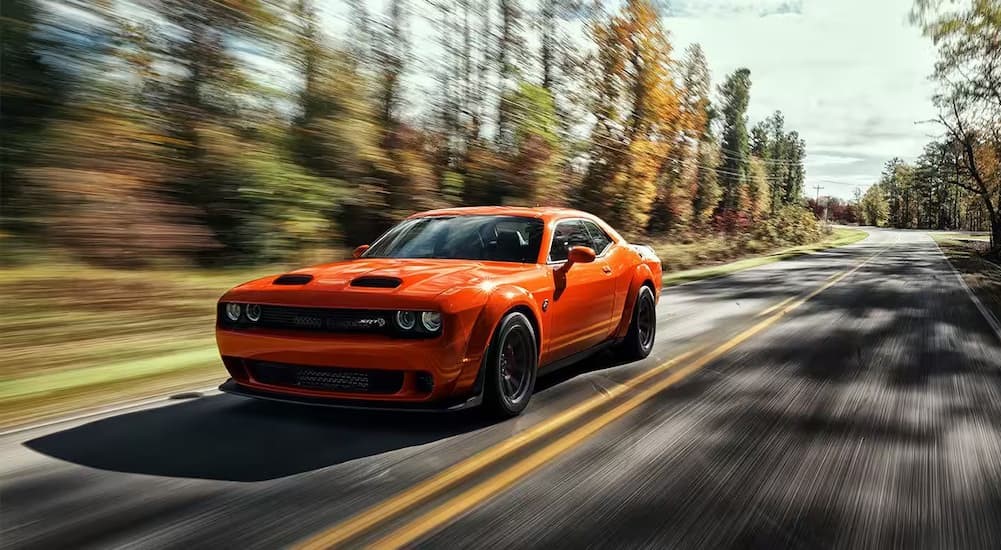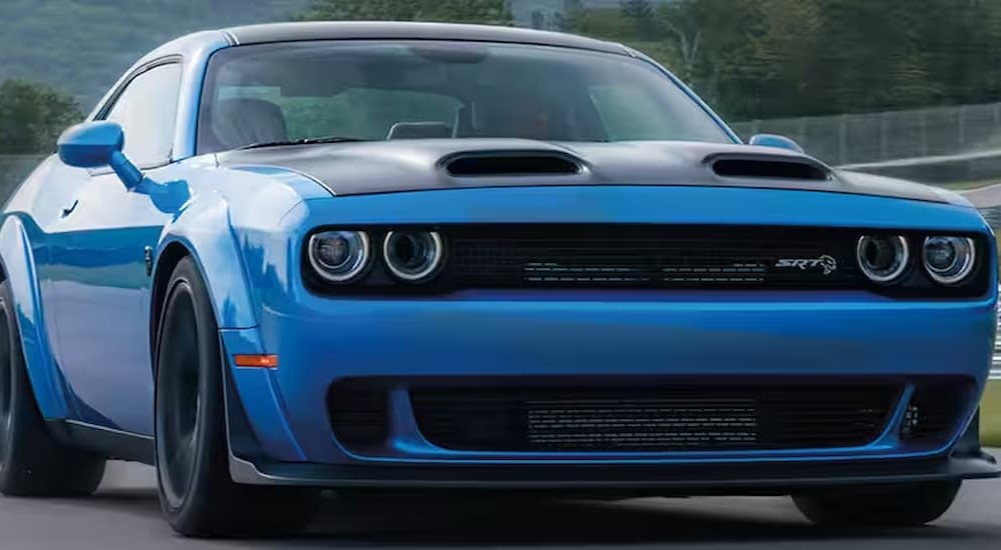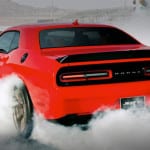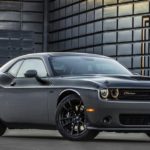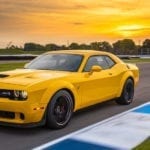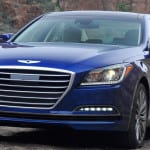How many personal luxury cars can you think of off the top of your head that are available as new model years being produced in America for American drivers? The cars that first come to mind that you’re about to rattle off are all European. The BMW 8 Series? The Porsche 911? The Mercedes-Benz C-Class? The Audi RS? The Jaguar F-Type? The personal luxury cars of old were American-made, two-door coupes, mass-marketed and produced, and provided a good sense of sports-themed luxury appeal. The majority of today’s sports-themed luxury cars are of the grand touring variety from Europe or the JDM offerings made available in America from Nissan, Honda, and Toyota.
That brings us to the question: is the Dodge Challenger the last of the personal luxury cars? The two-door coupe with sports-themed luxury appeal? And with the Challenger being converted into an alternative fuel sedan, will it mark the end of the era of the American-made personal luxury car segment? With the Challenger’s new model year outings having ended, does it also mean that the last of the personal luxury car will only be available from online auctions, a used Dodge dealership, or personal ads? These are all questions worth exploring via a topic that has drastically changed over the years throughout the American automotive landscape and could continue to change as the shakeup of alternative fuel vehicles and crossover segments redefines consumer expectations.
The Personal Luxury Car, or America’s Answer to the Grand Touring Automobile
The personal luxury car segment is America’s answer to what was known as the grand touring segment in Europe, which were (and still are) classically designed sports coupes with upscaled interiors, sophisticated lines, and motorsports-inspired powertrains. Americans sought to rival that but with mass market appeal instead of only aiming at the upper echelon of the auto market. Thus, the personal luxury car was born out of a boom with the introduction of the segment’s first entry, the Ford Thunderbird.
While arguments could be made that the Corvette was one of the first in the segment, the Thunderbird’s proper crossover appeal helped introduce the segment as a bona fide classification. This is because the Thunderbird – unlike the Corvette – focused more on luxury appeal than pure sports performance. The personal luxury car segment was a grade above the more economical pony car segment, which is where the Corvette and later the Mustang resided; yet the personal luxury car was a grade below the luxury sedan segment, which is where vehicles like the Buick Ninety-Eight or the Cadillac Fleetwood resided.
There was a town-car feel to the Thunderbird, where you could just as easily drive it to a movie premiere as you would a drag race on the weekend. Likewise, you could just easily use it as an executive car as you could a cruiser. It was sporty enough to be a sports car but classy enough to be a luxury car, yet it was still easily accessible to most of the market. This created the ruleset for the American personal luxury car segment: it had to be mass-produced or have wide market appeal, it had to be a two-door coupe or convertible, it had to be sporty, it had to have a unique design, it had to offer some kind of luxury cabin amenities, and it had to be comfortable to drive.
This ruleset was played with but saw a burgeoning outpouring of unique and awesome vehicles spread throughout the American automotive market by many of the big automakers of the time, from GM and Ford to AMC and Chrysler. This included a lot of very original vehicles, such as the Oldsmobile Toronado, the Buick Riviera, the Packard Caribbean, or the Studebaker Speedster. These were big, beautiful cars that were that proper crossover between a luxury town car and a sports coupe.
How the Dodge Challenger Became an Unlikely Entry in the Personal Luxury Segment
With the personal luxury segment seeing a big boom during the late 1950s and throughout the 1960s, many companies started getting in on the action to scoop up some of the market interest that was being heavily shown in the personal luxury car segment at the time. Chrysler was slow on the uptick, but when they attempted to offer a competitive alternative, they went with options that would become quite iconic.
But first, Chrysler needed a foundation on which to build their personal luxury car through the chosen Dodge brand. This foray came from the platform predecessor known as the Plymouth Barracuda in 1964, which was a compact, sports-performance pony car. The Barracuda laid the groundwork for the Dodge Charger, the latter of which came bustling onto the scene with massive V8 engines and a menacing look in 1966 as a two-door muscle car.
It was just in time to make for the perfect villainous foil for Steve McQueen’s Ford Mustang in the 1968 classic film Bullitt. The Charger had officially become known as a muscle car mean machine. However, Dodge wasn’t done breaking boundaries and attempting to sift through the competition to usurp car shoppers from different segments. Enter the Dodge Challenger.
In 1969, Dodge introduced the Challenger as a 1970 model year outing. It was larger than the Barracuda yet rode on a wheelbase several inches shorter than the Charger. It attempted to evolve past the standards of the pony car segment with a performance-rich array of powertrains while also separating itself from being a pure muscle car with luxury elements present within the Special Edition trim, which was available both as a hard top and as a convertible.
You could also get it with a special vinyl covering to add an extra sense of prestige to its exterior presence. Unlike the more aggressive grille of the Charger, the Challenger had a more traditional grille design that was more subdued, ensuring that it was seen as the less vicious of the two siblings. The interior consisted of available leather bucket seats and plenty of comfort amenities with a spacious yet very functional instrument cluster. The Dodge Challenger had essentially found itself in a grade above the economy class pony car while also being more luxurious than a muscle car, yet not as expensive as the luxury sedan. Hence, the Challenger had the makings of being a rather unlikely yet very noteworthy entry in the personal luxury car segment.
Reconvening with the Personal Luxury Car Segment
It’s safe to say that as the muscle car genre met an unfortunate end during the 1970s, many of the nameplates that became big during the 60s and 70s almost universally dropped off in popularity during the 1980s, and the Dodge Challenger was sadly one of them. It had a very disappointing yet short run through the 1980s before being discontinued. However, the Challenger came back during the third generation in 2008 with a vengeance, as a true return to muscle car form, sporting a very aggressive yet classically inspired design.
Much like how Ford made a modern version of the Thunderbird in 2005 that had a lot of throwback designs to the classic 1960s version, Dodge hearkened the third-generation’s visage back to the first-generation Challenger. A deliberate decision that rekindled the personal luxury car appeal that the Challenger embodied during its first model year out. There was a concept that was floating around during the mid-aughts that Dodge wanted to put into production, so lead designer Jeff Gale and design manager Brian Nielander worked to bring that concept to a production-ready model almost exactly how it was envisioned as a concept car, with only minor changes.
The final grille for the 2008 Dodge Challenger was more reminiscent of the first generation model year outing of the Challenger, as opposed to donning the classic Dodge cross-shaped grille featured in the concept. The profile lines for the third-generation Challenger were made to be exceptionally smooth, and the team worked hard to retain a lot of the classic personality of the interior from the original first-generation Challenger, including some of the asymmetric center console elements. But a lot of the intention of the design language was focused on muscle car culture and high-performance compatibility. But what about the personal luxury car theme?
Well, the town car appeal of the personal luxury cars from the 1960s and 1970s was far less of a goal for the designers of the third generation Challenger than what they had set out to do with the original first generation Challenger. The third-generation Challenger still retains many elements of the personal luxury car ethos, being a mass-market two-door coupe with a powerful array of high-performance powertrains and a focus on a uniquely sleek design.
For the third generation, the luxury car elements are applied only in the form of a leather-wrapped steering wheel, cloth bucket seats with lumbar support, and silver accent trimming featured throughout the dashboard. Optional two-tone interior designs are present, but the more town-car approach that the first-generation Challenger embodied was forfeited in place of a focus on performance. In many ways, the newer generation Challenger is more practical than its predecessors, even though it gives up some of the luxury elements as a result.
The Challenger Represents the End of the Personal Luxury Car Segment
As far as personal luxury cars go, the Dodge Challenger represents the end of an era when it comes to American-made sports coupes. There are still some two-door coupes made for mass market appeal, but they certainly aren’t made with the intention of competing with the likes of the iconic personal luxury cars of old, such as the 1973 Cadillac Eldorado or the 1970 Lincoln Continental. Most of the remaining mass-market, affordable two-door coupes sold in America aren’t American-made nor aimed at the luxury car shopper, such as the Toyota GR86, Nissan Z, or the Subaru BRZ.
The Dodge Challenger is a unique nameplate insofar that its design language, history, and focus have been on the same kind of car-shopping market that fell in love with the muscle cars and personal luxury line-up during the late 1950s, the 1960s, and the early 1970s. In many ways, the Dodge Challenger has been carrying a lot of mantles on its shoulders, representing multiple dwindling segments over the years, such as the American muscle car segment, the two-door town car segment, and the personal luxury car segment.
Even while the third-generation Dodge Challenger moved further away from the luxury elements of its past roots, it did manage to capture a lot of the identity that made that segment so enticing: A mixture of refined and sporty lines that weren’t gaudy or overdone; an aerodynamic profile that still managed to house a lot of class, and a muscular performance presence while on the road. Unfortunately, it all ended with the 2023 model year outing, as Dodge announced they are moving away from the high-performance internal combustion engine sedans to comply with the ever-strict emissions control standards.
The Future of the Personal Luxury Car
A uniquely designed two-door sports coupe with luxury appeal and a high-performance powertrain tucked under the hood – that also maintains mass market appeal – is the standard of what the personal luxury car used to be. That’s what made an American-made personal luxury car worthy of being classified as an entry in the segment. Is it possible that following the Dodge Challenger’s retirement as one of the last of the V8s and one of the last of the personal luxury cars, we could see its successor fit the requirements to become a personal luxury car?
Right now, all we know is that the Dodge Daytona Banshee is the working title of the BEV sports car set to come out, and it does accommodate some of the checks on the list. The Daytona Banshee is a two-door coupe. It certainly has a unique design, and it’s expected to be high-performance. What we don’t know is if it will have luxury appeal or if it will be available as a mass market and affordable vehicle just a grade above a typical pony car the way the Dodge Challenger was. If it is, then maybe the American-made personal luxury car could have a future yet, but until then, we can pay our respects to one of the most unique segments in the automotive industry by tipping a hat to the last of the bunch… the unforgettable Dodge Challenger.
